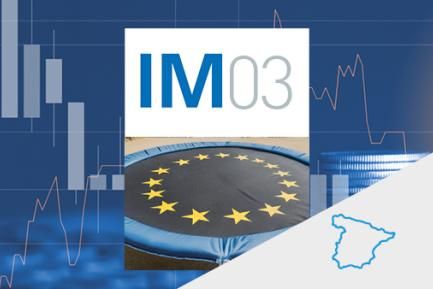The Spanish economy shows resilience in an adverse context

In Q1 2022, conditioned first by the sixth wave of COVID-19 and later by the outbreak of the war in Ukraine and the increase in disruptions in industry due to the lorry strike, GDP growth weakened compared to the preceding quarter, with quarterly growth standing at 0.3% compared to the previous 2.2%, marking the most moderate growth rate in the last 12 months. In year-on-year terms, GDP was 6.4% above the level of Q1 2021 and 3.4% below the pre-pandemic level (Q4 2019). This slowdown was due to weak private consumption, which fell by 3.7% quarter-on-quarter, pushing it 9.8% below the pre-pandemic level. The rise in uncertainty and inflation, with a surge in the price of essential goods, led to a marked contraction in spending on durable consumer goods (–11.3% quarter-on-quarter). Conversely, investment in equipment and exports increased their contribution to GDP growth. Specifically, investment in equipment rose by 7.6% on a quarterly basis and exports by 3.4%, driven by tourism (+21.9 quarterly), which now stands at 95.3% of the level of Q1 2019.

On the downside, the crisis is taking a heavy toll on inflation and on the energy component of the trade balance, where the deficit in annual terms has reached its highest since 2015. The economic sentiment indicators, meanwhile, show mixed signals, with a slight recovery in April among consumers and the services sector, while it continues to recede in the case of industry. On the other hand, there were positive surprises in the form of the significant recovery in tourism and the resilience of the labour market, which, albeit at a more moderate pace, continue to create jobs.

According to the National Statistics Institute’s flash estimate, there was a marked moderation in inflation in April, as it stood at 8.4% year-on-year (9.8% in March, the highest rate since 1985). While we await the breakdown by component, this reduction is most likely explained by the declines in electricity and fuel prices. The high energy prices continue to leak into the other components of the consumer price index. In particular, in April processed food prices pushed up core inflation (i.e. excluding the most volatile components), which climbed 1 point to 4.4%, the highest rate since December 1995. The agreement between Spain and Portugal and the European Commission to limit the price of gas used for electricity production to an average of €50/MWh over the next 12 months (a measure that has not yet entered into force) will help to contain inflationary pressures.

The consumer confidence indicator published by the European Commission improved slightly in April, +1.2 points to –27.1 points, while the services sector’s PMI climbed 3.7 points to 57.1 points, its highest level since November 2021, thanks to the surge in activity following the lifting of COVID-related restrictions. However, the industrial sector is the one suffering the most at the hand of the rising costs and supply constraints. Hence, the manufacturing PMI posted a 0.9-point decline in April, brining it to 53.3 points. This marks a 14-month low, albeit still in expansionary territory (above 50).

Both the results of the Q1 2022 LFS and the rise in Social Security affiliation confirm the resilience of the labour market. The number of people in employment according to the LFS grew at a quarterly, seasonally adjusted rate of 1.08% and the unemployment rate stood at 13.65%, 2.3 pps less than a year earlier. Social Security affiliation, meanwhile, gathered pace in April, driven by the spike in the tourism sector over Easter, growing by 184,577 people compared to 134,396 in April 2021. In seasonally adjusted terms, job creation is once again on the rise following the moderation in the previous two months. For the first time, the total number of Social Security affiliates exceeds 20 million, standing at 20,019,080, which is 963,782 more than a year ago. One particularly encouraging aspect is the significant increase in permanent contracts, representing 48.5% of all the contracts registered in the month, compared with the typical level in the month of April of around 10%. This growth was driven by the conversion of temporary jobs into permanent ones following the three-month adaptation period for the labour reform’s entry into force.

In the first two months of the year, the current account balance shows a deficit of 2,354 million euros, 35.9% more than in the same period of 2021. This deterioration is mainly explained by the widening of the energy deficit (−6,985 million compared to −3,110 million in 2021), in a context of a recovery in import volumes and a sharp rise in energy prices, which are 48.8% higher than in the first two months of last year.

In particular, the surplus accumulated in the first two months of the year amounts to 4,639 million euros, compared to 281 million in 2021. The first indicators that have been revealed bode very well for the summer season. For now, overnight stays by foreigners in hotel accommodation establishments reached 81% of the pre-pandemic level in March (74.5% in February) and spending registered on foreign cards over Easter was 4% higher than in the same period in 2019. Also, tourist mobility is recovering and interest in travelling to Spain is rapidly picking up, as reflected by the number of flights operated at Spanish airports and Google searches on trips to Spain, which are already at levels similar to those of 2019.


